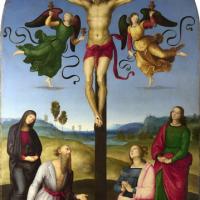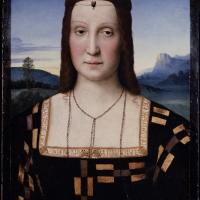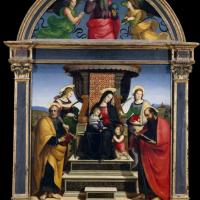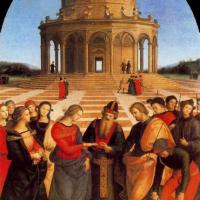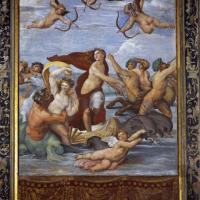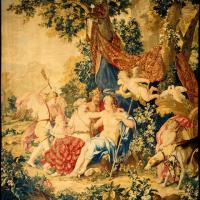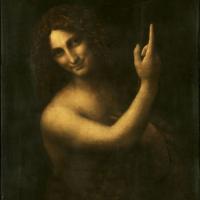. Raphael Sanzio (1483-1520)
Raffaello Sanzio da Urbino (March 28 or April 6, 1483 – April 6, 1520), known as Raphael was an Italian painter and architect of the High Renaissance. His work is admired for its clarity of form, ease of composition, and visual achievement of the Neoplatonic ideal of human grandeur. Together with Michelangelo and Leonardo da Vinci, he forms the traditional trinity of great masters of that period.
Raphael was enormously productive, running an unusually large workshop and, despite his death at 37, leaving a large body of work. Many of his works are found in the Vatican Palace, where the frescoed Raphael Rooms were the central, and the largest, work of his career. The best known work is The School of Athens in the Vatican Stanza della Segnatura. After his early years in Rome, much of his work was executed by his workshop from his drawings, with considerable loss of quality. He was extremely influential in his lifetime, though outside Rome his work was mostly known from his collaborative printmaking.
After his death, the influence of his great rival Michelangelo was more widespread until the 18th and 19th centuries, when Raphael's more serene and harmonious qualities were again regarded as the highest models. His career falls naturally into three phases and three styles, first described by Giorgio Vasari: his early years in Umbria, then a period of about four years (1504–1508) absorbing the artistic traditions of Florence, followed by his last hectic and triumphant twelve years in Rome, working for two Popes and their close associates.
Raphael painted several of his works on wood support (Madonna of the Pinks) but he also used canvas (Sistine Madonna) and he was known to employ drying oils such as linseed or walnut oils. His palette was rich and he used almost all of the then available pigments such as ultramarine, lead-tin-yellow, carmine, vermilion, madder lake, verdigris and ochres. In several of his paintings (Ansidei Madonna) he even employed the rare brazilwood lake, metallic powdered gold and even less known metallic powdered bismuth.
Vasari says that Raphael eventually had a workshop of fifty pupils and assistants, many of whom later became significant artists in their own right. This was arguably the largest workshop team assembled under any single old master painter, and much higher than the norm. They included established masters from other parts of Italy, probably working with their own teams as sub-contractors, as well as pupils and journeymen. We have very little evidence of the internal working arrangements of the workshop, apart from the works of art themselves, which are often very difficult to assign to a particular hand.
The most important figures were Giulio Romano, a young pupil from Rome (only about twenty-one at Raphael's death), and Gianfrancesco Penni, already a Florentine master. They were left many of Raphael's drawings and other possessions, and to some extent continued the workshop after Raphael's death. Penni did not achieve a personal reputation equal to Giulio's, as after Raphael's death he became Giulio's less-than-equal collaborator in turn for much of his subsequent career. Perino del Vaga, already a master, and Polidoro da Caravaggio, who was supposedly promoted from a labourer carrying building materials on the site, also became notable painters in their own right. Polidoro's partner, Maturino da Firenze, has, like Penni, been overshadowed in subsequent reputation by his partner. Giovanni da Udine had a more independent status, and was responsible for the decorative stucco work and grotesques surrounding the main frescoes. Most of the artists were later scattered, and some killed, by the violent Sack of Rome in 1527. This did however contribute to the diffusion of versions of Raphael's style around Italy and beyond.
Vasari emphasises that Raphael ran a very harmonious and efficient workshop, and had extraordinary skill in smoothing over troubles and arguments with both patrons and his assistants—a contrast with the stormy pattern of Michelangelo's relationships with both. However though both Penni and Giulio were sufficiently skilled that distinguishing between their hands and that of Raphael himself is still sometimes difficult, there is no doubt that many of Raphael's later wall-paintings, and probably some of his easel paintings, are more notable for their design than their execution. Many of his portraits, if in good condition, show his brilliance in the detailed handling of paint right up to the end of his life.
Other pupils or assistants include Raffaellino del Colle, Andrea Sabbatini, Bartolommeo Ramenghi, Pellegrino Aretusi, Vincenzo Tamagni, Battista Dossi, Tommaso Vincidor, Timoteo Viti (the Urbino painter), and the sculptor and architect Lorenzetto (Giulio's brother-in-law). The printmakers and architects in Raphael's circle are discussed below. It has been claimed the Flemish Bernard van Orley worked for Raphael for a time, and Luca Penni, brother of Gianfrancesco and later a member of the First School of Fontainebleau, may have been a member of the team.
Raphael was one of the finest draftsmen in the history of Western art, and used drawings extensively to plan his compositions. According to a near-contemporary, when beginning to plan a composition, he would lay out a large number of stock drawings of his on the floor, and begin to draw "rapidly", borrowing figures from here and there. Over forty sketches survive for the Disputa in the Stanze, and there may well have been many more originally; over four hundred sheets survive altogether. He used different drawings to refine his poses and compositions, apparently to a greater extent than most other painters, to judge by the number of variants that survive: "... This is how Raphael himself, who was so rich in inventiveness, used to work, always coming up with four or six ways to show a narrative, each one different from the rest, and all of them full of grace and well done." wrote another writer after his death. For John Shearman, Raphael's art marks "a shift of resources away from production to research and development".
When a final composition was achieved, scaled-up full-size cartoons were often made, which were then pricked with a pin and "pounced" with a bag of soot to leave dotted lines on the surface as a guide. He also made unusually extensive use, on both paper and plaster, of a "blind stylus", scratching lines which leave only an indentation, but no mark. These can be seen on the wall in The School of Athens, and in the originals of many drawings. The "Raphael Cartoons", as tapestry designs, were fully coloured in a glue distemper medium, as they were sent to Brussels to be followed by the weavers.
In later works painted by the workshop, the drawings are often painfully more attractive than the paintings. Most Raphael drawings are rather precise—even initial sketches with naked outline figures are carefully drawn, and later working drawings often have a high degree of finish, with shading and sometimes highlights in white. They lack the freedom and energy of some of Leonardo's and Michelangelo's sketches, but are nearly always aesthetically very satisfying. He was one of the last artists to use metalpoint (literally a sharp pointed piece of silver or another metal) extensively, although he also made superb use of the freer medium of red or black chalk. In his final years he was one of the first artists to use female models for preparatory drawings—male pupils ("garzoni") were normally used for studies of both sexes.


